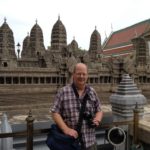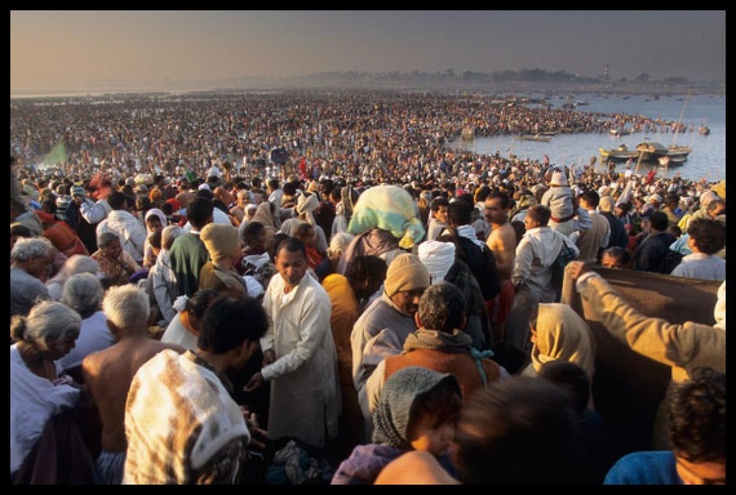Maha Kumbha Mela 2001: The Greatest Spiritual Festival and Gathering of People in the History of the World
SPIRITUALITY, 17 Jan 2022
Stephen Knapp (Sri Nandanandana dasa) – TRANSCEND Media Service
Every six years, the Kumbha Mela festival is the largest gathering of people, mostly Hindus, in the history of the world; what to speak of it being a religious festival. Over the course of its 41 days, it is calculated that as many as 70 million people of all kinds attend the Kumbha Mela. However, this year, 2001, saw an amazing increase in the number of people who came from the West, even famous movie stars, curious to see what the Mela is all about. Actually, the Kumbha Mela festival is for anyone who has a high regard for knowledge of the soul and spiritual inquisitiveness.
It is a time when hundreds of thousands of pilgrims come to associate with the numerous sadhus, saints, and spiritual teachers from numerous traditions who attend the Mela. It is also the time when the power of the sacred rivers, namely the Ganges, Yamuna and Sarasvati, are at their peak. So, one of the highlights of attending the festival is to take a holy bath in the sacred rivers. Therefore, such activities as associating with the saints, checking out the camps, and bathing in the sacred rivers are on the agenda of most everyone who attend the Kumbha Mela.
But why is this festival so unique? Why do so many people from all over the world come to participate in this religious festival? What are its benefits? And what happens at this festival?
You can find out the answers to these questions through the fascinating articles listed below. You can also look through the photos that we have provided in order for you to see some of what takes place at this amazing festival. Nothing compares with this event, which will leave you a changed person after having attended. Just click on the links below to learn more.
* * *
A Description of the Kumbha Mela takes you through some of the experience of what it is like to be at the Kumbha Mela, to visit some of the spiritual camps, to witness the large numbers of people, the bathing at the confluence of the Ganges, Yamuna, and Sarasvati Rivers, and the parade of saints on the important bathing days.
An Extra Report on the Kumbha Mela describes some of the background information of what it takes to prepare for such a huge event and try to have it run successfully, and some of what happened there that many pilgrims may not have known.
The Legend of the Kumbha Mela is a report that describes the ancient history of the place and why this event has such importance from the traditional point of view, and by using quotes from the Vedic texts that describe this time-honored event and location.
* * *
Photographs of the Kumbha Mela are provided through the links below. These are divided into groups of several to a page for faster downloading. Altogether there is a selection of 40 photos that give a little view of what it was like to spend a couple days at the Mela over the Amavasya day (January 24, 2001), which was one of the most important days of the whole festival, as explained in the articles listed above. Again, it’s quite difficult to pick out such a small selection of photographs out of the hundreds that I took while at the Kumbha Mela. Take your time and look at some of what happened at the largest spiritual gathering of people to ever assemble on the planet. [These photographs are also accessed through the Seeing Spiritual India page.]
Kumbha Mela Photos Group One: Coming to the Mela, views of the city of tents, pilgrims and sadhus coming to the Mela, 8 photos.
Kumbha Mela Photos Group Two: A look at some of the camps, temples, and one of the most lively groups at the Mela, according to the BBC, the Iskcon Krishna camp, 11 photos.
Kumbha Mela Photos Group Three: A look at the holy men known as the Naga Babas, at night at the Mela, and the auspicious “Parade of Saints” on Amavasya (New Moon) day, January 24, 2001, 12 photos.
Kumbha Mela Photos Group Four: Views of the huge crowds bathing in the at the sangam area (the meeting place of the Ganges and Yamuna rivers) on Amavasya day, plus sunset and nightfall over the Kumbha Mela, and last thoughts, 10 photos.
__________________________________________________
 Stephen Knapp (Sri Nandanandana dasa) has dedicated himself to spreading the deepest and most practical levels of spiritual knowledge about the soul–our real identity. Though this world may give us numerous challenges, when we rise above the basic materialistic view and its limited search for solutions, our evolutionary development on all levels greatly accelerates. By recognizing that we are all spiritual beings who are, basically, attempting to achieve the same essentials for our existence–namely love, acceptance, harmony, peace, and happiness, not to mention the ordinary needs of food, water, clothing and shelter–we can reach a new level of cooperation with each other. Stephen has written many books on this and related subjects and studied with A. C. Bhaktivedanta Swami Prabhupada becoming initiated into the spiritual line of Brahma-Madhava-Gaudiya sampradaya. He is also president of the Vedic Friends Association. srinandan@aol.com
Stephen Knapp (Sri Nandanandana dasa) has dedicated himself to spreading the deepest and most practical levels of spiritual knowledge about the soul–our real identity. Though this world may give us numerous challenges, when we rise above the basic materialistic view and its limited search for solutions, our evolutionary development on all levels greatly accelerates. By recognizing that we are all spiritual beings who are, basically, attempting to achieve the same essentials for our existence–namely love, acceptance, harmony, peace, and happiness, not to mention the ordinary needs of food, water, clothing and shelter–we can reach a new level of cooperation with each other. Stephen has written many books on this and related subjects and studied with A. C. Bhaktivedanta Swami Prabhupada becoming initiated into the spiritual line of Brahma-Madhava-Gaudiya sampradaya. He is also president of the Vedic Friends Association. srinandan@aol.com
Go to Original – stephen-knapp.com
Tags: History, India, Kumbha Mela, Religion, South Asia, Spirituality, Tradition
DISCLAIMER: The statements, views and opinions expressed in pieces republished here are solely those of the authors and do not necessarily represent those of TMS. In accordance with title 17 U.S.C. section 107, this material is distributed without profit to those who have expressed a prior interest in receiving the included information for research and educational purposes. TMS has no affiliation whatsoever with the originator of this article nor is TMS endorsed or sponsored by the originator. “GO TO ORIGINAL” links are provided as a convenience to our readers and allow for verification of authenticity. However, as originating pages are often updated by their originating host sites, the versions posted may not match the versions our readers view when clicking the “GO TO ORIGINAL” links. This site contains copyrighted material the use of which has not always been specifically authorized by the copyright owner. We are making such material available in our efforts to advance understanding of environmental, political, human rights, economic, democracy, scientific, and social justice issues, etc. We believe this constitutes a ‘fair use’ of any such copyrighted material as provided for in section 107 of the US Copyright Law. In accordance with Title 17 U.S.C. Section 107, the material on this site is distributed without profit to those who have expressed a prior interest in receiving the included information for research and educational purposes. For more information go to: http://www.law.cornell.edu/uscode/17/107.shtml. If you wish to use copyrighted material from this site for purposes of your own that go beyond ‘fair use’, you must obtain permission from the copyright owner.
